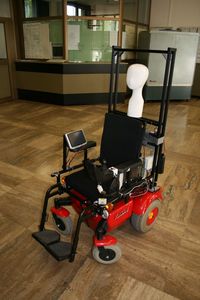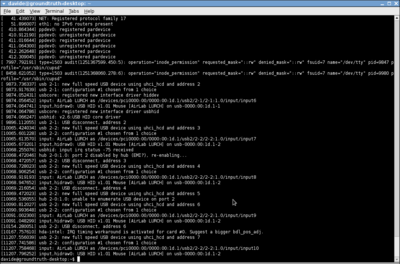Difference between revisions of "LURCH - The autonomous wheelchair"
| Line 10: | Line 10: | ||
| type= | | type= | ||
| status=Active | | status=Active | ||
| − | | image= | + | | image=LURCH wheelchair.jpg |
}} | }} | ||
| − | [[Image:LURCH wheelchair.jpg|thumb|right|300px|LURCH in DEI exploration]] | + | <!--[[Image:LURCH wheelchair.jpg|thumb|right|300px|LURCH in DEI exploration]]--> |
| + | |||
L.U.R.C.H. is the acronym of "Let Unleashed Robots Crawl the House". | L.U.R.C.H. is the acronym of "Let Unleashed Robots Crawl the House". | ||
Revision as of 23:38, 13 October 2009
LURCH_-_The_autonomous_wheelchair
| |
| Coordinator: | |
| Tutor: | AndreaBonarini (andrea.bonarini@polimi.it), MatteoMatteucci (matteo.matteucci@polimi.it), SimoneCeriani (ceriani@elet.polimi.it), DavideMigliore (d.migliore@evidence.eu.com) |
| Collaborator: | |
| Students: | MatteoRossi (), MauroBrenna () |
| Research Area: | warning.png"Robotics;Computer Vision and Image Analysis" is not in the list of possible values (Affective Computing, Agents - Multiagent Systems - Agencies, BioSignal Analysis, Computational Intelligence and Games, Computer Vision and Image Analysis, E-Science, Machine Learning, Philosophy of Artificial Intelligence, Robotics, Social Software and Semantic Web) for this property.Robotics;Computer Vision and Image Analysis |
| Research Topic: | |
| Status: | Active |
L.U.R.C.H. is the acronym of "Let Unleashed Robots Crawl the House".
LURCH is an extended version of an commercial electric wheelchair (Rabbit by OttoBock) equipped with:
- An interface circuit for digital drive via a radio serial link (XBee modules)
- Two on-board computers (PCBricks), powered by wheelchair batteries
- A 7-inch touchscreen monitor (Xenarc 700TSV), 800x480 resolution (16:10 AR)
- Two laser scanners Hokuyo URG 04LX
- A colour camera FireI400 (resolution 640×480)
- An odometry system based on encoders applied to the rear wheels
Main goals of the LURCH project are:
- Add sensors and robotic functionalities to the powered wheelchair.
- Add various command interfaces, such as Joypad wireless, speech command, brain-computer interface.
- Semi-autonomous navigation with collision and obstacle avoidance.
- Autonomous navigation by path planning and localization.
Functions currently provided by LURCH:
- Driving by the original joystick or a Logitech RumblePad2 wireless joypad.
- Obstacle sensing using planar scanner lasers.
- Basic collision and obstacle avoidance behaviours.
- Indoor localization by a fiducial marker system
- Path planning and basic autonomous navigation.
- Brain-computer interface driving system
Contents
Media Coverage
Lurch project appeared in many national and international media. You can see the related articles and videos in the MediaCoverage page.
Available Documentation
- Documentation on the interface circuit between the wheelchair joystick and computer: Media:LurchCircuitDocument.pdf.
- WARNING: the circuit was modified and the documentation above is upgraded by this new file: Media:LurchXBee.pdf.
- How to modify the wheelchair joystick to connect to the interface circuit: Media:LurchCircuitJoystick.pdf.
- Brief discussion about the interface circuit between the wheelchair joystick and computer: Media:LurchCircuitJoystickBrief.pdf.
- Brief description of the LURCH project: Media:LurchBriefDesc.pdf.
- Brief description of the communication between the wheelchair interface circuit and a PC via RS232 port: Media:LurchProtocol.pdf.
- Source code for PIC 18F452 microprocessor and Eagle project (schematic and board): Media:LurchCircuitProject.zip.
- Battery replacement done on May 2009, description of work: Media:LurchBatteryReplacement.pdf.
- Thesis by Simone Ceriani, titled Sviluppo di una carrozzina autonoma d'ausilio ai disabili motori (Development of an autonomous wheelchair to help motor-disabled persons): Media:LurchThesisCeriani.pdf (in Italian)
- Thesis presentation by Simone Ceriani (note: Videos don't work, you can found similar videos below): Media:LurchPresentazioneThesisCeriani.zip
- Thesis by Marco Dalli, titled Sviluppo di un sistema di controllo basato su odometria per una carrozzina robotica (Development of a control system based on odometry for a robotic wheelchair): Media:LurchThesisDalli.pdf (in Italian)
- Thesis presentation by Marco Dalli: Media:LurchPresentazioneThesisDalli.zip
- Pdf with ArtoolKitPlus Fiducial Markers collection. Dimension are 160x160mm. Media:ArtoolKitPlusMarkers-160mm.pdf.zip
PCBricks Configuration
PCBrick-03 and PCBrick-05 feature Xubuntu Linux 7.10, Xfce Window Manager, Openchrome graphics drivers and eGalax touchscreen drivers v1.08.1227 (Drivers here). The touchscreen is configured and calibrated on both machines, hence it can be used with either one or the other indifferently.
Electronics development
We are currently designing a new electronic main board for the wheelchair. The idea is to base the whole system on a CANbus, allowing a complete modularization of the on-board electronics.
We are now evaluating the CANOpen standard, that provides high-level communication layers by implementing the ISO/OSI stack on top of the CANbus.
This should ensure automatic error recognition and resolution, device addressing and packet segmentation/desegmentation.
One of the modules that will be connected to the CAN bus is the USB mouse. For development and debug purposes, a simple master/slave system has been put together using two PIC18F4550 microcontrollers
The USB mouse is emulated by a PIC18F4550 microcontroller; this unit features an on-board USB module that can be controlled by the HID (Human Interface Device) Library provided with the mikroC PRO for PIC compiler.
The USB HID Class Definition states that the device must provide the host a descriptor in which it informs the lattest on which kind of informations it will generate.
The Device Descriptor identifies which other class descriptors are present, and indicates their size (for example, Report and Physical descriptors).
A Report Descriptor describes each piece of data that the device generates, and what the data is actually measuring;
A Physical Descriptor (optional) provides information about the part(s) of the human body used to operate the device.
HID devices support a variety of protocols:
- 0 = None
- 1 = Keyboard
- 2 = Mouse
- 3...255 = Reserved
Our descriptor will use protocol 2.
All the descriptors will be automatically handled by the HID Library, but we have to provide a valid mouse Report Descriptor, similar to the following:
- Usage Page: 0x05, 0x01 (Generic Desktop)
- Usage: 0x09, 0x02 (Mouse)
- Collection: 0xA1, 0x01 (Application)
- Usage: 0x09, 0x01 (Pointer)
- Collection: 0xA1, 0x00 (Physical)
- Usage Page: 0x05, 0x09 (Buttons)
- Usage Minimum: 0x19, 0x01 (01) Button 1
- Usage Maximum: 0x29, 0x03 (03) Button 3
- Logical Minimum: 0x15, 0x00 (0) Button idle
- Logical Maximum: 0x25, 0x01 (1) Button pressed
- Report Count: 0x95, 0x03 (3) 3 buttons available
- Report Size: 0x75, 0x01 (1) One bit per button
- Input: 0x81, 0x02 (Data, Variable, Absolute) Variables
- Report Count: 0x95, 0x01 (1) Padding
- Report Size: 0x75, 0x05 (5) 5 bits
- Input: 0x81, 0x03 (Constant) Constant padding
- Usage Page: 0x05, 0x01 (Generic Desktop)
- Usage: 0x09, 0x30 (X)
- Usage: 0x09, 0x31 (Y)
- Logical Minimum: 0x15, 0x81 (-127)
- Logical Maximum: 0x25, 0x7F (127)
- Report Size: 0x75, 0x08 (8)
- Report Count: 0x95, 0x02 (2)
- Input: 0x81, 0x06 (Data, Variable, Relative)
- End Collection: 0xC0
- End Collection: 0xC0
- Collection: 0xA1, 0x01 (Application)
Analyzing this table one can see how a Report Descriptor is organized: it is formed by multiple items, each providing its own data size, count and type, along with the range of values that it will generate. The standard mouse descriptor declares:
- Three button items, that take only one bit each and can assume only logic levels (0 or 1); this is obtained by setting Report Count to 3, Report Size to 1 and choosing 0 and 1 as Logical Minimum and Maximum.
- One 5-bit padding to be added to obtain a byte (HID descriptors only accept complete bytes); a 5-bit constant value (Input set to 0x06).
- Two axes items (X and Y) that take a whole byte each and whose values can range from -127 to 127; Report Count is set to 2, Report Size to 8 (bits) and the range is set by Logical Minimum and Maximum.
An appropriate descriptor was generated using the HID Descriptor Tool provided by the USB organization. The output of this tool was then copied into the source file we obtained from the HID Terminal provided with the compiler. The result is the USBDsc.c file that we included in our project and can be downloaded here: Media:USBDsc.zip.
The HID Library is a very convenient way to handle USB communication in PIC microcontrollers; it only consists in five methods:
- Hid_Enable() activates the USB module and enables the USB interrupt;
- Hid_Disable() deactivates the USB module and interrupt;
- Hid_Read() populates the input buffer with data coming from the USB host;
- Hid_Write() sends data from the output buffer to the USB host;
- Hid_InterruptProc() must be called from the interrupt handling routine and automatically processes USB interrupts.
The programmer only has to create a Report Descriptor for his device and produce/consume data to be sent/read from the bus. The mikroC IDE also features an HID Terminal (similar to MS Windows HyperTerminal) that can be used to easily debug the code by sending and receiving data to/from a given HID device.
Our firmware repeatedly polls the status of the buttons and sends appropriate data to the host in order to move the cursor and operates the two buttons.
A simple circuit has been designed to test the mouse firmware:
All the components have been placed on a small piece of perfboard to test the circuit on different computers and operating systems:
The mouse emulator was instantly recognized by all the operative systems we tested it on:
- Microsoft Windows XP SP2
- Microsoft Windows Vista
- Ubuntu Linux 9.04
- Mac OS X 10.5.8
By now, the movements of the mouse pointer are controlled by simple buttons, and the values of the X,Y axes can only be [-20; 0; 20]; in the final release, the joystick will drive the pointer with proportional values, allowing more intuitive and precise control.
LURCH YouTube Videos
Software Installation [TODO: complete]
This guide is tested on Ubuntu 8.10, 9.04 and Xubuntu 8.10. GCC version in 4.3.
- Install the following packages:
- qt3-dev-tools
- qt4-dev-tools
- build-essential
- flex
- bison
- libjsw-dev
- libboost-dev
- libdc1394-13-dev
- libgsl0-dev
- libgtk2.0-dev
- libncurses5-dev
If you want you can cut and paste this command line: sudo apt-get install ...
- Download this file: [TODO], which contains ARToolKitPlus Libraries
- unpack it in /opt folder
- go into /opt/ARToolKitPlus_2.1.1
- export ARTKP=/opt/ARToolKitPlus_2.1.1
- qmake
- make
- sudo make install
- download lurch-control.tar.gz
- extract it in your home folder
- make cleanall
- make ROBOT=wheelchair MODULE=misc
- make ROBOT=wheelchair
- cd wheelchair
- ln -s ../logExtract.sh ./
- ln -s ../run.sh ./
- download lurch-wheelchair-standalone.tar.gz
- extract it in your home folder
- go into lurch-wheelchair-standalone/config
- edit config.ini
- replace line with hostname=airlab-blackbox with hostname=<yourhostname>
- edit agent.ini
- find and replace all "airlab-blackbox" with <yourhostname>
- download the server for simulation (you need sun-java6-jdk installed and Eclipse is suggested)
...
- from lurch-wheelchair-standalone
- sudo ./run.sh
People Involved
Marco Dalli (ex-Tesista)
Simone Ceriani (Assegnista di ricerca)
Matteo Rossi (Tesista)
Marco Assini (Tesista)
Mauro Brenna (Tesista)
Laboratory work and risk analysis
Laboratory work for this project is mainly performed at AIRLab/Lambrate. It includes some mechanical work and electrical and electronic activity. Potentially risky activities are the following:
- Use of mechanical tools. Standard safety measures described in Safety norms will be followed.
- Use of soldering iron. Standard safety measures described in Safety norms will be followed.
- Transportation of heavy loads (e.g. robots). Standard safety measures described in Safety norms will be followed.
- Robot testing. Standard safety measures described in Safety norms will be followed.







